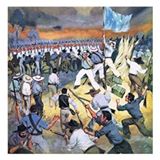Today marks the 161st anniversary of the storming by British troops of the Eureka Stockade at Ballaarat.
Much has been written by all sorts of people about Eureka and its legacy – and of course, about the blue and white Flag of The Southern Cross.

For the nationalists, Eureka symbolises in the higher meaning, the shedding of blood on our soil for freedom, akin as that idea is to the refusal to recognize unjust authority.
In the context of Australian modernity, the state that governs us is not our state, but an entity hell-bent on cleansing the Australian identity and transferring the sovereignty of our land to foreigners, who by that right, acquire the people’s wealth and resources.
Our image below is of the Chips Rafferty film about Eureka Stockade. The film, despite its historical errors, encapsulated a little of the Australia of our past, our rich broad accent of English and common style.
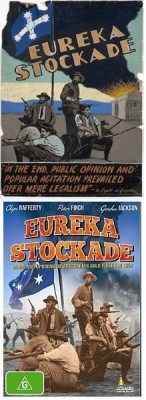
We publish Henry Lawson’s 1887 poem “Flag of the Southern Cross“, which best sets out the ideological quality of the flag of Eureka Stockade.
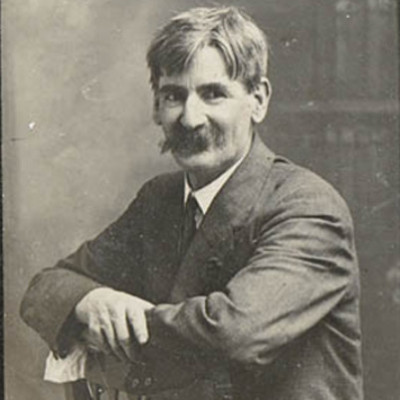
Flag of the Southern Cross
(Henry Lawson,1887)
Sons of Australia, be loyal and true to her —
Fling out the flag of the Southern Cross!
Sing a loud song to be joyous and new to her —
Fling out the flag of the Southern Cross!
Stain’d with the blood of the diggers who died by it,
Fling out the flag to the front, and abide by it —
Fling out the flag of the Southern Cross!
See how the toadies of Austral throw dust o’er her —
Fling out the flag of the Southern Cross!
We who are holding her honour in trust for her —
Fling out the flag of the Southern Cross!
See how the yellow-men next to her lust for her,
Sooner or later to battle we must for her —
Fling out the flag of the Southern Cross.
Beg not of England the right to preserve ourselves,
Fling out the flag of the Southern Cross,
We are the servants best able to serve ourselves,
Fling out the flag of the Southern Cross.
What are our hearts for, and what are our hands for?
What are we nourished in these southern lands for?
Fling out the flag of the Southern Cross.
Shall we in fear of the Dragon or Bruin* now
Keep back the flag of the Southern Cross?
Better to die on a field of red ruin now,
Under the flag of the Southern Cross.
Let us stand out like the gallant Eureka men —
Give not our country the sorrow to seek her men —
Fling out the flag of the Southern Cross!
See how the loyal are storing up shame for us
Under the light of the Southern Cross.
Never! Oh! never be coward a name for us —
Fling out the flag of the Southern Cross!
England’s red flag will bring hatred and worse to it,
Murder and rapine hath brought a black curse to it;
Fling out the flag of the Southern Cross!
Have we not breasts for the bullets of thunderers?
Fling out the flag of the Southern Cross!
Have we not steel for the bosoms of plunderers?
Fling out the flag of the Southern Cross!
Prove ourselves worthy the land we inherit now,
Feed till it blazes the National spirit now!
Fling out the flag of the Southern Cross!
Let us be bold, be it daylight or night for us —
Fling out the flag of the Southern Cross!
Let us be firm — with our God and our right for us,
Under the flag of the Southern Cross!
Austral is fair, and the idlers in strife for her
Plunder her, sneer at her, suck the young life from her!
Fling out the flag of the Southern Cross!
Fling out the flag to the front, and abide by it —
Fling out the flag of the Southern Cross!
Stand by the blood of the diggers who died by it —
Fling out the flag of the Southern Cross!
Fling out the flag to the front, and be brave for it.
Liberty! Light! or a battle-field grave for it!
Bonny bright flag of the Southern Cross!
Editor’s note: “Dragon or Bruin” is a then-reference to China (the Chinese dragon) and Russia (the Russian bear, or “bruin”)
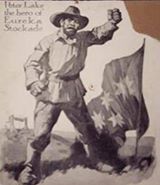
The Vintage pre-1973 Star-Spangled Eureka Flag
According to the eminent Dr Whitney Smith writing in 1975, the Eureka flag “perhaps because of its association with labor riots and a time of political crisis in Australian history, was long forgotten.
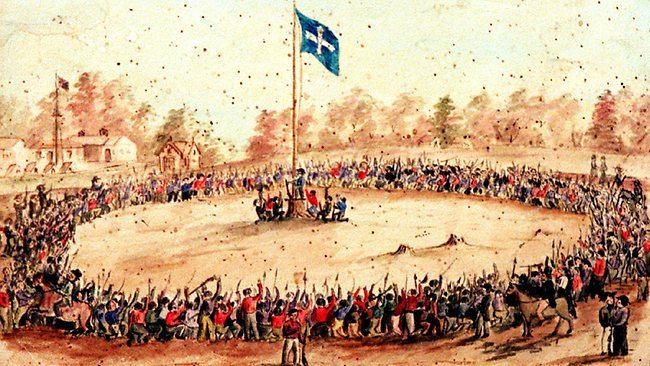
Bakery Hill
A century after it was first hoisted, however, Australian authors began to recognise that it had been an inspiration, both in spirit and design, for many banners up to and including the current official civil and state flags of the nation.”
J.W. Wilson, was also of the view that the Eureka flag, which he claimed to have devised, was an influence on the design of the 1901 Australian national flag, saying “Since then, however, the Stars have been placed on the bunting beside the Union Jack of Old England, and long may the flag remain the ensign for Australia!”
However not everyone remains convinced as to this supposed continuity and lineage. The first concept for a continental design, the National Colonial flag for Australia, which was devised in either 1823 or 1824, also features the five white stars of the Southern Cross configured on the red cross of Saint George. Also predating the Eureka flag was the Australian Anti-Transportation League Ensign, which from 1851 also featured the constellation, but in the form of five free-floating stars. The following exchange which took place in the Australian parliament during debate over the Flags Act is also indicative of this difference of opinion:
Mr Calwell – The honorable member for Balaclava waxed rhetorical about the symbolic significance of the blue background. I do not disagree with anything that he said but it is true that there is also an historical significance in the blue background, but not of the kind about which the honorable member spoke. A flag with a blue background was specially chosen by the men who made the famous stand at the Eureka Stockade.
Mr Beale – What rot!
Mr Calwell – It may upset the Minister for Supply (Mr. Beale) to know that Eureka played a part in Australian history and that the flag of Eureka is perpetuated in the blue background of our flag.
However the influence of the flag of the United States of America which beginning in 1777 popularised the use of stars must also be acknowledged.
It does seem that the Eureka rebellion and flag are not altogether as deeply rooted in Australian history and the popular culture as some of their more over eager aficionados will insist. The evidence given here as to the existence of a star-spangled Eureka flag, as featured in publications and motion pictures from at least the late 1940s right up until the 1973, when the unique Eureka flag specimen was first authenticated and put on display at the Ballarat Fine Art Gallery, makes the reverse look rather more likely, with the traditional Australian national flag and its array of southern stars being a primary influence on early post World War II Eureka writers, artists and producers. Seen here are two posters promoting the 1949 movie Eureka Stockade showing both the star-spangled and standardised Eureka flag.
With respect to the provenance of the star-spangled Eureka flag, in an article by Withers published in the Ballarat Star, 1 May 1896, the maybe reliable John McNeil is mentioned as recalling a meeting on Bakery Hill where one Robert McCandlish “unbuttoned his coat and took out an unfurled a light blue flag with some stars on it, but there was no cross on it”.
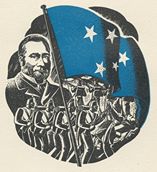
Seen here are some examples taken from Clive Turnbull’s 1946 “Eureka: the story of Peter Lalor” and a poster of the rebel commander-in-chief taken from the Ballaarat Historical Society collection. Also included in this selection is Clive Upton’s “Storming the Eureka Stockade”, as featured on the front cover of the 14 February 1970 Eureka Stockade Australian edition of the London-based Look and Learn historical magazine as sold to school students.
